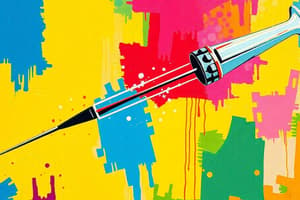Podcast
Questions and Answers
What is the primary concern associated with needle stick injuries?
What is the primary concern associated with needle stick injuries?
- Damage to the surrounding tissue
- Causing immediate severe pain
- Introducing air into the bloodstream
- Introducing bloodborne pathogens (correct)
Which of the following is NOT a recommended post-exposure protocol after a needle stick injury?
Which of the following is NOT a recommended post-exposure protocol after a needle stick injury?
- Apply alcohol to disinfect the wound (correct)
- Report the incident to a supervisor
- Seek medical attention for assessment
- Wash the wound thoroughly with soap and water
Which infectious diseases are commonly associated with needle stick injuries?
Which infectious diseases are commonly associated with needle stick injuries?
- Tuberculosis and Influenza
- Measles and Mumps
- HIV, Hepatitis B, and Hepatitis C (correct)
- Herpes Simplex and Zika Virus
What is a critical prevention strategy for needle stick injuries?
What is a critical prevention strategy for needle stick injuries?
What should be included in the documentation of a needle stick injury?
What should be included in the documentation of a needle stick injury?
Flashcards are hidden until you start studying
Study Notes
Definition
- Needle stick injury refers to a puncture wound caused by a needle that can introduce bloodborne pathogens.
Causes
- Accidental needle sticks during:
- Medical procedures (e.g., injections, venipuncture)
- Disposing of sharps improperly
- Handling used needles
- Inadequate safety precautions or distractions during procedures.
Common Risks
- Potential exposure to infectious diseases such as:
- Human Immunodeficiency Virus (HIV)
- Hepatitis B (HBV)
- Hepatitis C (HCV)
Symptoms
- May not show immediate symptoms.
- Pain, bleeding, or localized swelling at the injury site.
- Psychological impact, including anxiety about disease transmission.
Post-Exposure Protocol
-
Immediate Steps:
- Wash the wound thoroughly with soap and water.
- Encourage bleeding from the site (if applicable).
- Do not apply alcohol, bleach, or caustics to the injury.
-
Medical Evaluation:
- Report the incident to a supervisor.
- Seek medical attention for assessment and necessary preventive treatment.
-
Follow-up:
- Baseline blood tests for HIV, HBV, and HCV.
- Post-exposure prophylaxis (PEP) for HIV may be initiated within 72 hours.
- Counseling and monitoring for health outcomes.
Prevention Strategies
- Utilize safety-engineered devices (e.g., retractable needles).
- Implement proper disposal of sharps in designated containers.
- Training and education on safe handling practices.
- Establish and follow clear protocols for exposure response.
Reporting and Documentation
- Document the injury details (time, date, circumstances).
- Record the type of needle involved and patient information (if applicable).
- Complete any required incident reports as per organizational policies.
Legal and Ethical Considerations
- Compliance with Occupational Safety and Health Administration (OSHA) regulations.
- Understanding personal liability and institutional responsibilities in prevention and response.
Needle Stick Injury Definition
- A puncture wound caused by a needle that can introduce bloodborne pathogens into the body.
Causes
- Accidents during medical procedures (e.g., injections, drawing blood).
- Improper disposal of sharp objects like needles.
- Handling used needles without proper safety precautions.
Common Risks
- Exposure to infectious diseases such as HIV, Hepatitis B, and Hepatitis C.
Symptoms
- May not have immediate symptoms.
- Pain, bleeding, or swelling at the site of the injury may occur.
- Psychological impact, such as anxiety about disease transmission.
Post-Exposure Protocol
- Immediate Steps:
- Wash the wound thoroughly with soap and water.
- Encourage bleeding from the site (if applicable).
- Do not use alcohol, bleach, or caustics to clean the injury.
- Medical Evaluation:
- Report the incident to a supervisor.
- Seek medical attention for assessment and preventative treatment.
- Follow-up:
- Blood tests for HIV, HBV, and HCV are recommended as baseline.
- Post-exposure prophylaxis (PEP) for HIV may be initiated within 72 hours of the exposure.
- Counseling and monitoring for health outcomes are important.
Prevention Strategies
- Use safety-engineered devices like retractable needles.
- Dispose of sharps in designated containers properly.
- Training and education on safe handling practices are crucial.
- Establish and follow clear protocols for responding to exposure incidents.
Reporting and Documentation
- Document the injury details, including time, date, and circumstances.
- Record the type of needle involved and patient information (if applicable).
- Complete any required incident reports according to organizational policies.
Legal and Ethical Considerations
- Compliance with OSHA regulations is essential.
- Understanding personal liability and institutional responsibilities in prevention and response is key.
Studying That Suits You
Use AI to generate personalized quizzes and flashcards to suit your learning preferences.




